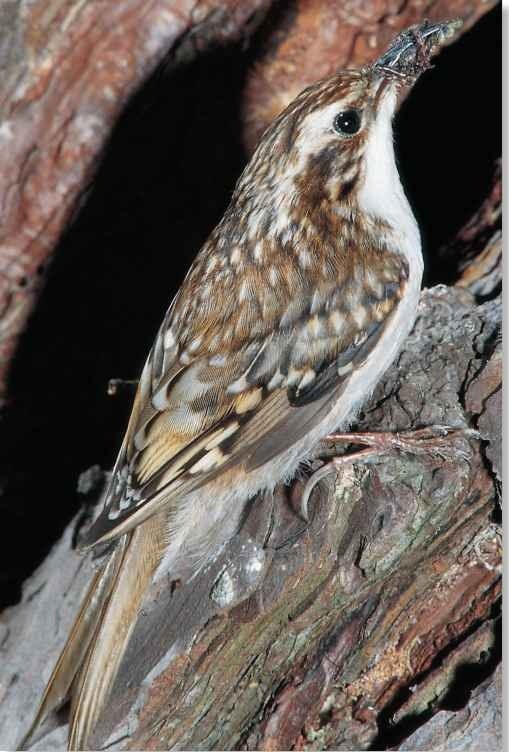ORDER
Passeriformes
FAMILY
Certhiidae
GENUS & SPECIES
KEY FEATURES
• A sparrow-sized bird of woodland and forests
• Creeps up tree trunks and along branches to probe the bark for hidden insects and spiders
• Climbs each tree in same way, by starting near its base and moving up the trunk in spirals
* • Small groups survive inter nights by huddling together in spaces behind loose bark
WHERE IN THE WORLD?
Found across most of Europe and Asia to eastern China and Japan; separate populations occur in the Caucasus Mountains and Himalayas; also across most of North America
Lifecycle
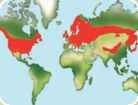
At first glance, the brown creeper looks more like a mouse than a bird as it scurries up tree trunks, stopping every now and again to extract prey from crevices in the bark.
HABITAT
Although the brown creeper feeds in a highly specialized way, it lives in a wide range of wooded habitats, from dense forests to small woods in farmland, hedgerows, parks and wooded gardens, even in cities. It stays close to tree trunks and large branches, but is sometimes seen on small treetop twigs and on crumbling walls.
In central Europe, where the short-toed treecreeper occurs, the brown creeper is largely confined to coniferous woods and mountainous areas, so as to avoid competition for food and nest sites with its relative, which prefers deciduous woodland in the lowlands.
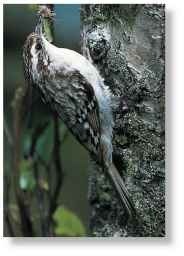
A Buried treasure
Old trees with loose, flaking bark are best for hunting.
CONSERVATION
In harsh winters, brown creeper numbers can suffer large declines, but they usually recover within a few successful breeding seasons. Modern forestry practices have led to local declines, as the bird favors mature trees mixed in with dead or rotting timber, and avoids the fast-growing, frequently felled trees of commercial forests.
BREEDING
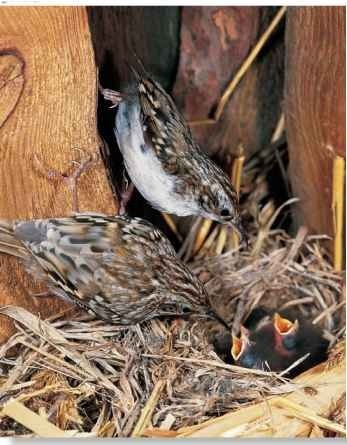
In spring, the male brown creeper regularly performs a high-pitched song from high in a tree to defend his nesting territory from rivals and to attract females. When a potential mate finally arrives, he chases her around tree trunks and through the air, shivering his wings to show off their bold coloring. As part of his courtship, he feeds her tasty morsels, delicately placing the food straight into her bill.
The pair builds a cosy nest behind loose bark or ivy, at the bottom of a hole in a tree, or in a cavity (left), such as that made by a lightning strike. The female usually lays 5 or 6 eggs. She incubates them alone for two weeks or so, but the male then helps her to feed the chicks for up to 16 days.
► Hanging around A recent fledgling may cling to bark for several days before making its first flight.
FEEDING THE FAMILY
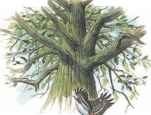
1 Flying start…
With a hungry brood to feed, a parent flies to the base of an old tree and begins to glean systematically.
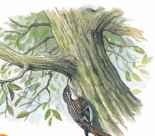
2 Up and up…
It walks slowly up the trunk, closely examining every little nook and cranny in the bark as it goes.
BEHAVIOR
The camouflage on the brown creeper’s upperparts makes it easy to escape the attention of humans, and is very hard for predators to spot. If pursued, it deploys evasive tactics to outwit its enemies: it runs to the other side of the tree trunk, where it can suddenly change direction, or makes quick “side-steps” across the trunk. However; its flight is weak and butterfly like.
Except during the breeding season, the brown creeper leads a rather solitary life, staying close to its nesting territory In winter, it may join a mixed flock of other small woodland birds in the search for food.
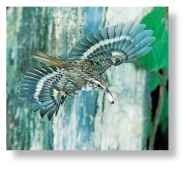
A Spring cleaning Adults remove youngs’ droppings from the nest.
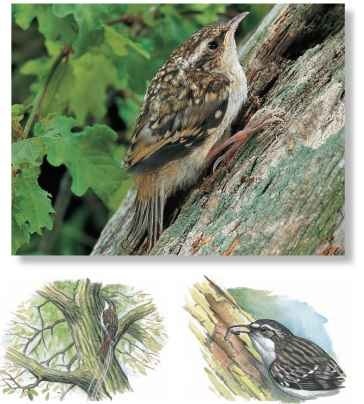
3 Round and round…
The brown creeper climbs in long spirals, disappearing behind the trunk to reappear again much higher up.
4 Grubs up
The only time this bird stops moving is to pause to extract an insect or grub from the bark.
FOOD & FEEDING
The brown creeper shares its woodland habitats with other insectivorous (insect-eating) birds, including warblers, kinglets, nuthatches and flycatchers, but its specialized bill can probe into places they can’t reach. Most of its prey is easily pulled out and swallowed whole, but the bird sometimes struggles to pry grubs from their tight-fitting holes. The brown creeper may look like a tiny woodpecker, but it cannot peck or drill with its delicate, needlelike bill.
The brown creeper’s diet consists mainly of spiders, woodlice, weevils and other small beetles, earwigs and moths. It devours adult insects and spiders, as well as their eggs and larvae, especially fat grubs and caterpillars. In winter, the brown creeper may supplement this diet with seeds, especially from pine and spruce trees.
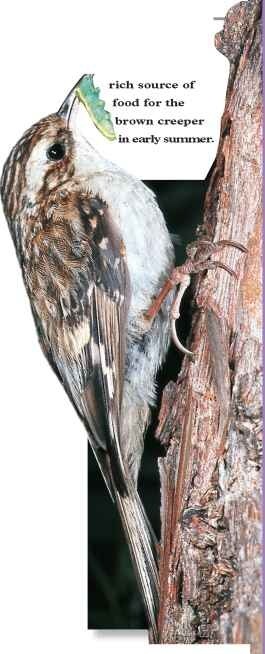
Juicy harvest Caterpillars are a
Woodpeckers are among the brown creeper’s more unlikely predators.
The male often makes several nests, and his mate chooses her preferred location.
In England, soft-barked redwood trees from North America have become a favorite roost site.
An old name for the brown creeper is the tree mouse.
Profile
Brown Creeper
Using its strong claws as climbing hooks, the brown creeper walks up tree trunks to extract prey from the bark with its fine, tweezerlike bill.
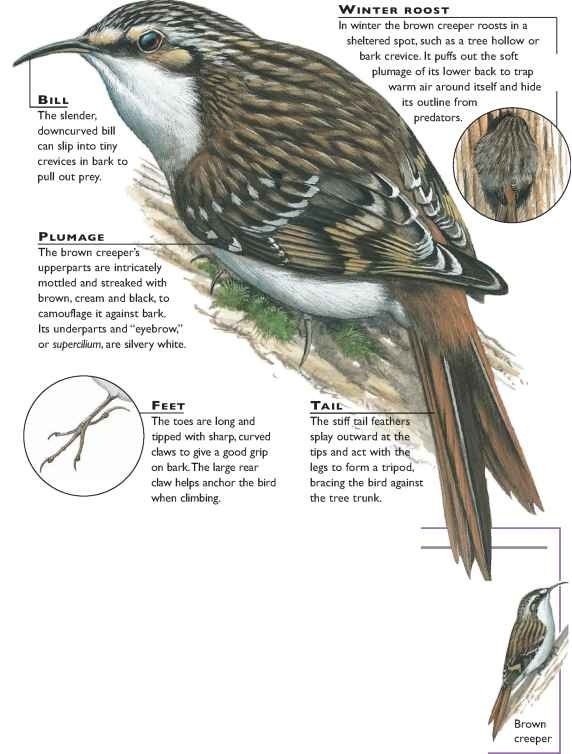
CREATURE COMPARISONS
Many birds can climb vertical surfaces, but few are as skilled as the wallcreeper (Tichodroma murarid), which is found in rocky gorges and on high crags in many mountain ranges in Europe and Asia. It climbs rock faces in search of insects, and can even cling underneath overhangs of rock.
Wallcreeper (male)
The wallcreeper’s body is similar to the brown creeper’s, but is larger and lacks the long, stiffened tail that its relative uses as a brace. Instead, it flicks open its colorful, scarlet-and-black wings for balance and support. The female wallcreeper’s plumage is grayer than the male’s, with less red on the wings.
| VITAL STATISTICS Weight 0.28-0.42 oz. |
|
| Length | 5″ |
| Wingspan | 7-8.5″ |
| Sexual I Maturity | 1 year |
| Breeding I Season | April-August |
| Number of Eggs | 3-9; usually 5-6 |
| Incubation Period | 14-15 days |
| Fledging Period | 14-16 days |
| t Breeding Interval | 1 year |
| Typical Diet | Invertebrates, such as insects ,. and their eggs, spiders and woodlice; some seeds in winter |
| Lifespan | Up to 9 years |
RELATED SPECIES
• There are 7 species of small, tree-climbing bird in the brown creeper family, Certhiidae; includes 5 treecreeper species and the brown and spotted-gray creepers. They are similar in appearance and habits to the Sittidae: a family of tree- and rock-climbing birds that includes the wallcreeper and 21 species of nuthatch. Both families belong to the order Passeriformes, which has over 5,700 species.
